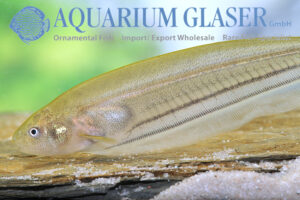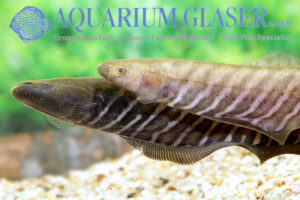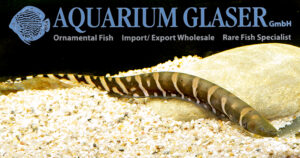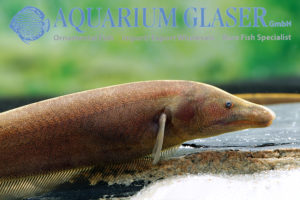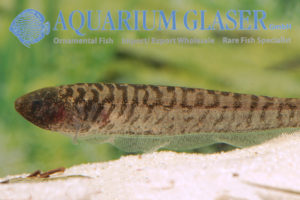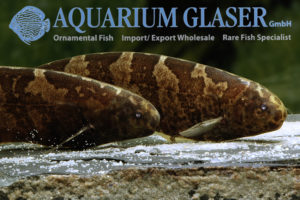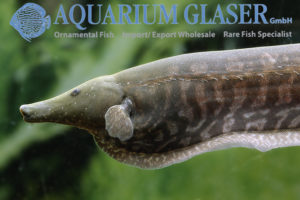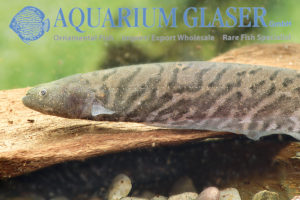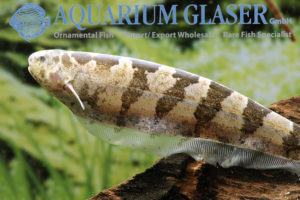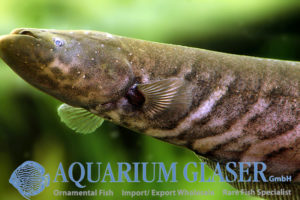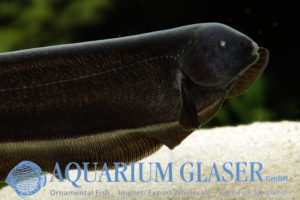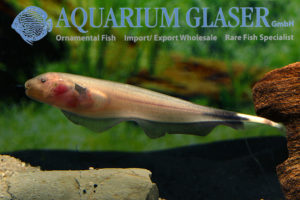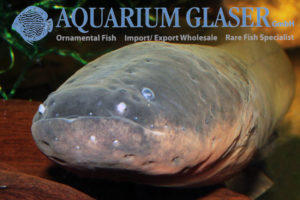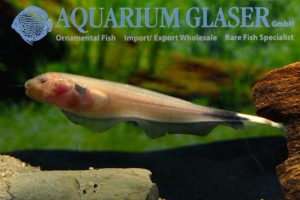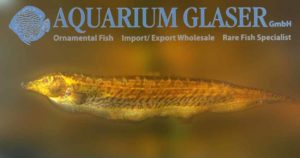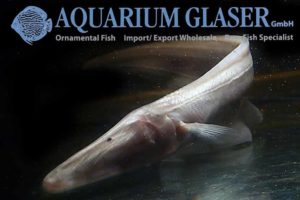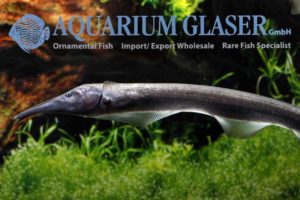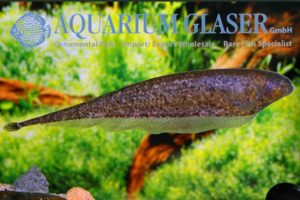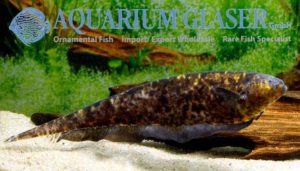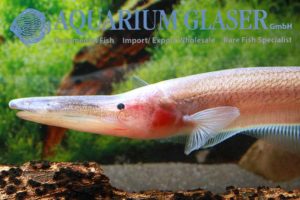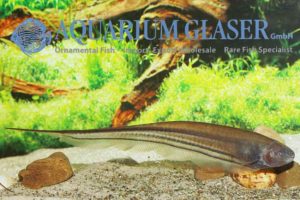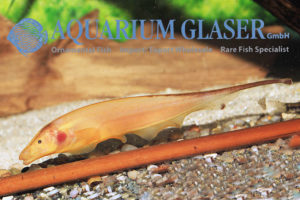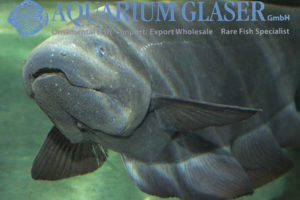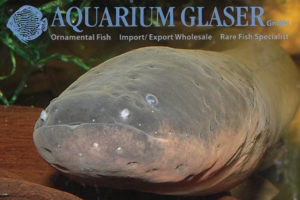The glass knifefishes (Eigenmannia), also known as green knifefishes, are a difficult and very complex group of fishes from a systematic point of view. They are widespread throughout the South American subcontinent and, together with other knifefish, make up a significant proportion of the fish biomass in many biotopes. The first species was already described […]
11. Gymnotiformes: Knifefishes of the New World (26)
-
-
Gymnotus carapo occidentalis
The banded knifefish (Gymnotus carapo) is one of the first species to be recorded in modern science and was described as early as 1758. It has – according to traditional opinion – an enormously wide distribution in South America, but one should bear in mind that many earlier reports of the species are probably based […]
-
Gymnotus javari
With currently 45 recognized species (as of January 2024), the genus Gymnotus is the most species-rich group of New World knifefish. Research into the species diversity of Gymnotus only began at the turn of the millennium; until then, only around 12 species were differentiated. From 2001 onwards, comprehensive papers with species descriptions and phylogenetic analyses […]
-
Apteronotus leptorhynchus (A. macrostomus)
The “Brown Ghost” is one of the most popular knifefishes in the aquarium. The species is not small, but not huge either: the maximum length to be expected is about 20 cm. This makes it less than half the size of its black cousin (A. albifrons). It is fascinating to observe knifefish in the aquarium. […]
-
Brachyhypopomus brevirostris
Knifefishes are found in Africa, Asia, and South America, with Old World and New World species not closely related. As aquarium fishes, knifefishes are particularly attractive because their elegant swimming style, created by the long anal fin extending over the belly and tail, is fascinating to watch. Like ghosts, the animals glide forward as well […]
-
Steatogenys duidae
From Peru we have received exceptionally nice knifefishes of the species Steatogenys duidae. According to current knowledge the genus Steatogenys comprises three species, all of which have zebra-like stripes. With a final length of about 20 cm they remain comparatively small, only S. ocellatus grows significantly larger at 30 cm. The three species are very […]
-
Rhamphichthys rostratus
Since some time we can offer a very interesting knife-fish species of the genus Rhamphichthys, which we receive as offspring from Indonesia. Rhamphichthys are attractive fish, but they require strong nerves from their keeper, because they rest lying on their side and look like dead at first sight. But they are very happy, only sleeping. […]
-
Gymnotus carapo
The number of scientifically described species in the genus Gymnotus increases rapidly recently. Since the last complete revision of the New World Knifefishes by Francisco Mago-Leccia in 1994 34 new species and 7 subspecies have been described, raising the total number of known species to 43. Members of the genus Gymnotus are cylindrical shaped and […]
-
Steatogenys elegans
From Peru we have received extremely pretty knife fish of the species Steatogenys elegans. The genus Steatogenys comprises three species, which are all zebra-like striped. With a total length of approximately 20 cm, they remain comparatively small, only S. ocellatus clearly becomes bigger with 30 cm. The three species are very similar in color. One […]
-
Gymnotus chaviro
More and more species of Gymnotus become known to science. Gymnotus chaviro originates from Peru. Here it inhabits the basin of the upper Rio Jurua. The species is found together with its close relative G. carapo. The pattern of G. chaviro is species-specific. However, there is one usefull feature mentioned in the original description: the […]
-
Sternarchogiton preto
Most probably this importation of this black knifefish from Peru („preto“ means „black“) is the first one to Europe. At least the pictures of a life specimen we post here are the only ones we know about. The uniform black coloration is a good feature to distinguish the species from other members of the genus […]
-
Apteronotus albifrons WHITE
The Black Ghost (Apteronotus albifrons) is a most beautiful and elegant knifefish from South America. The species has a very wide distribution, wild collected specimens most often come from the Orinoco (Colombia and Venezuela). However, the up to 50 cm long species is also bred since many years in Indonesia on a regular basis. The […]
-
How to pack 600 Volts!
The Electric Eel, Electrophorus electricus, has the strongest electric discharges of all known electric species of fish (electric catfish, electric rays, elephant fishes, knifefishes). Up to 600 Volts are quite common, very large specimens may produce even stronger discharges. The Electric Eel is no eel at all, but belongs to the New World Knifefishes. Five […]
-
Apteronotus albifrons WHITE
The Black Ghost (Apteronotus albifrons) is a most beautiful and elegant knifefish from South America. The species has a very wide distribution, wild collected specimens most often come from the Orinoco (Colombia and Venezuela). However, the up to 50 cm long species is also bred since many years in Indonesia on a regular basis. The […]
-
Rhamphichthys hahni
Yesterday we received for the first time ever an extremely unusual species of knifefish from Paraguay: Rhamphichthys hahni. We obtained three specimens of about 20-30 cm length. Despite the fact that the species has been described in the year 1937 already it has been overlooked by most of the following scientists. The photos posted here […]
-
Orthosternarchus tamandua
There are several critters among the South American knifefishes, but Orthosternarchus tamandua is most probably the most unusual of all. We were able to import a specimen from Peru. Our fish has a length of 25-30 cm, the maximum length reported for the species is about 45 cm. For our customers: the fish has code […]
-
Sternrachorhynchus from Peru
This week we introduced to you already a species of knifefish from Peru: Brachyhypopomus brevirostris (see http://www.aquariumglaser.de/en/news.php#1122). The odd Sternarchorhynchus, which is theme of this newsletter, originates also from Peru, but belongs to a different family, eg the Apteronotidae. The number of described species of Sternarchorhynchus has risen enormously in the past few years. Up […]
-
Adontosternarchus clarkae
Marbled Dwarf Ghosts. The most important species New World Knifefishes or Ghosts in the ornamental fish trade are without any doubt the Black Ghost (Apteronotus albifrons) and the Brown Ghost (A. leptorhynchus). We have both species in stock on a regular basis, the Black Ghost both as wild collected from Colombia/Venezuela and bred ones, the […]
-
Adontosternarchus nebulosus
For the first time ever we can offer this very nice and comparatively small species (around 20 cm) of knifefish. The species has been described scientifically only in 2007; our specimens originate from Peru. Available in limited numbers only! For our customers: the fish have code 202794 on our stocklist. Please note that we exclusively […]
-
Compsaraia samueli
Only a few specimens of one of the most remarkable knifefishes of the New World reached us from Peru: Compsaraia samueli. The males of this “pelicano knifefish” develope grotesque long snouts. The males are absolutely intolerant against each other. They fight with mouths wide open in a manner that is known from fighting male deer. […]
-
Eigenmannia trilineata
We received wonderful specimens of Eigenmannia from Guyana. They show three black longitudinal stripes on a smokey ground. This fits perfectly to the pattern described in the species E. trilineata, which is known so far only from the Paraguay-Paraná system (Argentina, Brazil, Paraguay, Uruguay). May that be as it is: Eigenmannia are fantastic aquarium fish […]
-
Adontosternarchus clarkae
This small (maximum length up to 20 cm) knifefish from Venezuela is only rarely imported and again we were able to obtain only a few specimens. It is a very nice and peaceful species. The genus Adontosternarchus currently comprises four accepted species which can be distinguished best by differences in the head profile in combination […]
-
Apteronotus leptorhynchus GOLD
A very special knifefish reached us currently from Colombia: a golden Apteronotus leptorhynchus! The species is widespread and common in Colombia and we have the “Brown Ghost” regularly stocked; but this is the first time ever that we became aware of a specimen with such an unique coloration. For our customers: the animal has code […]
-
Parapteronotus bonapartii
There is a lot of movement in the South American Knifefishes. Science has put an eye on these fascinating, electrical fishes and so a flood of new species descriptions and revisions has been published quite recently. Most genera and species are only weakly electric and use the electric pulses for orientation and communication. However, the […]
-
Newly in: Electric eels
Wonderful Electric eels (Electrophorus electricus) from Peru reached us lately. The animals are 40-50 cm long. The three of them are astonishingly peaceful among each other and feed readily. The fish have nice pale spots on the flanks, which are typical for specimens from Peru and which make the fish even more attractive. For our […]
-
Gymnorhamphichthys cf. hypostomus
The sand knifefishes (Rhamphichthyidae) from South America belong to the weak electric fishes. They send continously electric impulses which are used for tracing prey, orientation, and intraspecific communication. Currently three genera and 14 species are known. The genus Gymnorhamphichthys, also called thermometer knifefishes, contents five described species. There is hardly anything known about the fish, […]





